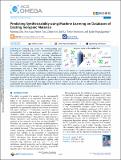Predicting Synthesizability using Machine Learning on Databases of Existing Inorganic Materials
Author(s)
Zhu, Ruiming; Tian, Siyu Isaac Parker; Ren, Zekun; Li, Jiali; Buonassisi, Tonio; Hippalgaonkar, Kedar; ... Show more Show less
DownloadPublished version (3.523Mb)
Publisher with Creative Commons License
Publisher with Creative Commons License
Creative Commons Attribution
Terms of use
Metadata
Show full item recordAbstract
Defining the metric for synthesizability and predicting new compounds that can be experimentally realized in the realm of data-driven research is a pressing problem in contemporary materials science. The increasing computational power and advancements in machine learning (ML) algorithms provide a new avenue to solve the synthesizability challenge. In this work, using the Inorganic Crystal Structure Database (ICSD) and the Materials Project (MP) database, we represent crystal structures in Fourier-transformed crystal properties (FTCP) representation and use a deep learning model to predict synthesizability in the form of a synthesizability score (SC). Such an SC model, as a synthesizability filter for new materials, enables an efficient and accurate classification to identify promising material candidates. The SC prediction model achieved 82.6/80.6% (precision/recall) overall accuracy in predicting ternary crystal materials. We also trained the SC model by only considering compounds uploaded on the MP before 2015 as the training set and testing on multiple sets of materials uploaded after 2015. In the post-2019 test set, we obtain a high 88.60% true positive rate accuracy, coupled with 9.81% precision, indicating that newly added materials remain unexplored and have high synthesis potential. Further, we provide a list of 100 materials predicted to be synthesizable from this post-2019 dataset (highest SC) for future studies, and our SC model, as a validation filter, is beneficial for future material screening and discovery.
Date issued
2023-03-07Department
Massachusetts Institute of Technology. Department of Mechanical EngineeringJournal
ACS Omega
Publisher
American Chemical Society (ACS)
Citation
Zhu, Ruiming, Tian, Siyu Isaac Parker, Ren, Zekun, Li, Jiali, Buonassisi, Tonio et al. 2023. "Predicting Synthesizability using Machine Learning on Databases of Existing Inorganic Materials." ACS Omega, 8 (9).
Version: Final published version